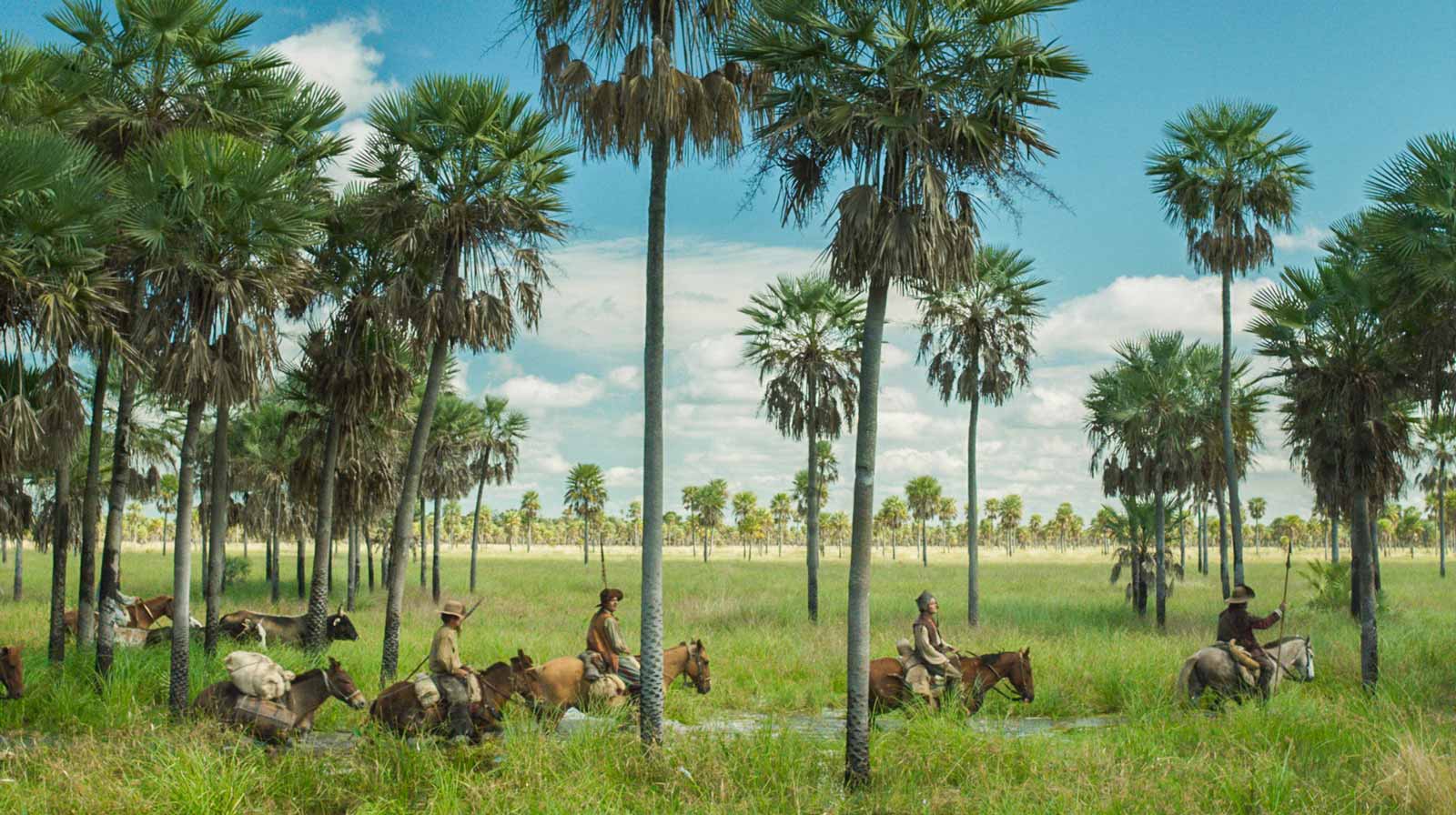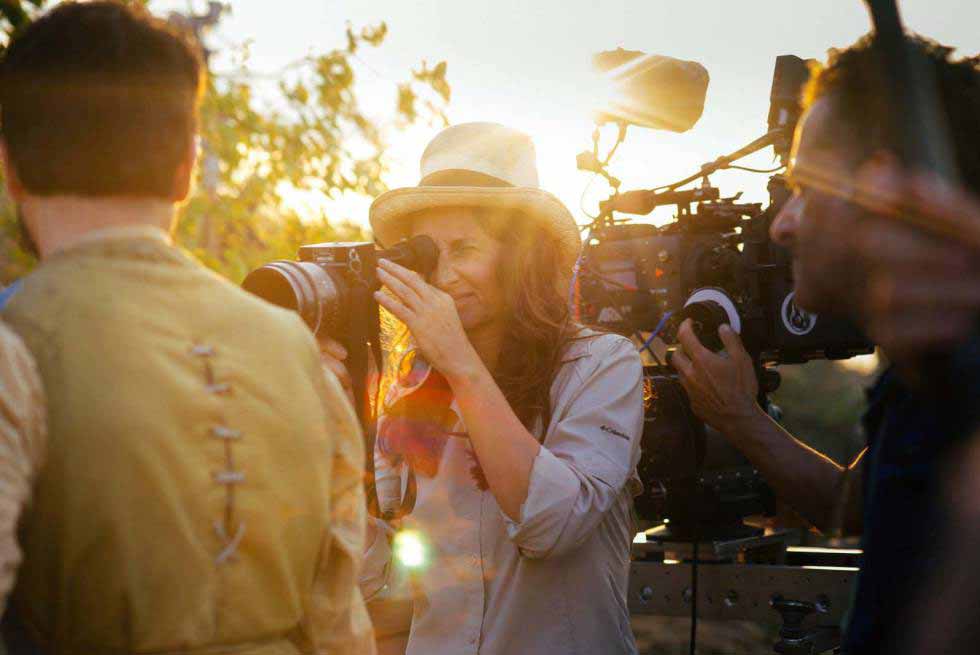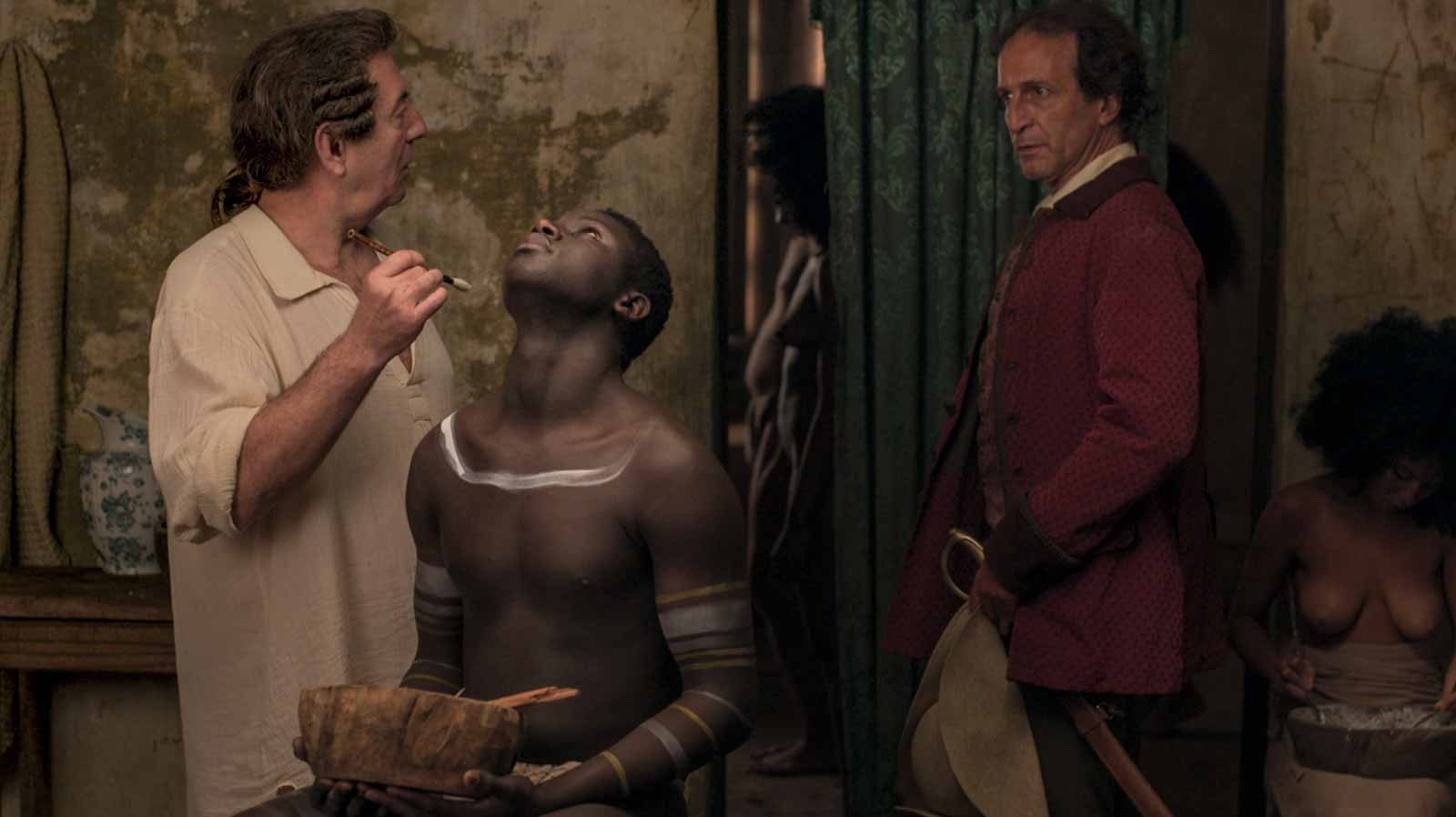Following the 2008 release of her internationally acclaimed The Headless Woman, Lucrecia Martel began discussing her next film. It would be a remarkable break from her previous features, known collectively as the Salta Trilogy for the city in Argentina’s Lerma Valley where Martel grew up and where they are set. All three were written by Martel, depict a female protagonist, and take place during the past half-century. Her fourth film, however, would adapt a beloved Argentine classic published in the 1950s. Unlike the earlier films, this one would not be set in the present but in an indeterminate future under attack by evil forces from outer space.
The extraterrestrial invasion in The Eternaut—a sci-fi comic by Héctor Germán Oesterheld, with drawings by Francisco Solano López, which first appeared as a series between 1957 and 1959—starts with the fall of a snow-like substance that instantly kills almost everyone in Buenos Aires and, perhaps, the world. A handful of survivors are left to confront the alien beings, which are, the humans come to realize, mere shells, controlled from afar by unseen forces: Them. When Juan Salvo and his wife and daughter try to escape, he unwittingly sets off a time machine that disperses the three into separate continuums; Salvo becomes a traveler in eternity, the eternaut, forever seeking his lost family. By 1975, when Oesterheld began publishing a sequel, the Argentine military was busily annihilating anyone it deemed a political opponent; he sent the new episodes to the publishers from hiding. In 1977, the military junta “disappeared” him and all four of his daughters; none of them ever came back.
Martel began working on a script and even paid a visit to George Lucas’s Industrial Light & Magic Studio in San Francisco to investigate special effects. But negotiations with the producers broke down and suddenly the project was off. No film of The Eternaut has yet been made.
At the end of 2009, Martel and a group of friends took a boat trip along the Paraná River in northeastern Argentina. On hot nights, amid clouds of mosquitos, they all read the same book: Antonio Di Benedetto’s Zama, another revered Argentine classic, also published during the 1950s, which also centers on the traumatic experiences of a male figure, lost in time. Its author, too, was disappeared by the Argentine state terror apparatus of the 1970s, but Di Benedetto’s fate was less terrible than Oesterheld’s: after eighteen months of imprisonment and torture, he was released and went into exile in Spain. He only returned to Argentina two years before his death in 1986, at the age of sixty-four.
Zama takes place in 1790, 1794, and 1799—the titles of its three sections. The narrator, Don Diego de Zama, is a functionary of the Spanish Empire stationed in Asunción, Paraguay. Though second in power only to the region’s governor, he feels trapped in this colonial backwater—far from his wife and children and the brilliant career he hopes for. He wants a transfer and spends much time and energy trying to persuade the distant powers that control his destiny to grant one. He does not succeed.
Martel experienced “a crazed euphoria, like a ravenously barking dog that’s finally eating,” when she finished the novel for the first time. As she wrote in El País last year:
What we call masterpieces of literature manage to weave a very particular toxin into their letters, one that sickens, maddens, and then transforms humans into better animals. It’s not something you can explain by describing events or characters. It’s something that happens in the writing. In the order and selection of the words… The particular way Di Benedetto makes use of language in Zama allows us to see something we’d never seen before. A region of the planet only made visible by passing through those letters.
There was no edition of Zama in the English-language book world until August 2016, when my translation of the novel was published. (Similarly, The Eternaut, though it developed a large cult following among readers in many languages, didn’t appear in English for the first time until 2015, published by Fantagraphics in a taut, Dragnet-inflected translation by Erica Mena.) Martel’s Kabbalistic understanding of Zama’s original language—the sorcerous power of the exact sequence of those letters and words in that particular order—is entirely betrayed by any translation, which has no option but to present different letters and words in different sequences. As I adapted the novel from Spanish to English, though, what I struggled with most were not words but silences: the imperative that the translation not say what the original leaves unsaid. Each sentence of the story’s first-person narration constitutes a self-portrait of its narrator; the silences between them are the blinkered, beleaguered being of Don Diego de Zama.
Advertisement
In 2012, when I was deep in many rounds of revisions of my translation, I learned that Martel was working on Zama, too. I watched La Ciénaga (2001) and La Niña Santa (2004) and marveled at the degree to which her films resembled Di Benedetto’s prose. In moments of doubt and frustration over what was happening in Don Diego’s spiraling tangle of words, I would ponder the strange confluences between Martel and Di Benedetto and imagine what she might be creating out of the same elusive lines. Before it even existed, her Zama had an impact on my understanding and translation of Di Benedetto’s.
In the history of film adaptation, Zama is an exceptional case. Both Di Benedetto and Martel are portraitists of the provincial, the marginal, whose stories uncannily tell us more about what’s left unsaid or unseen than about what’s written on the page or shown on the screen. In Di Benedetto’s fictions and Martel’s films, the fate of the defenseless—the young, the mute, the disabled, animals—doesn’t often appear to be the subject but always is. (The most memorable image in The Headless Woman, for instance, is the one thing never seen on screen: the corpse of an indigenous boy killed in a car accident by the protagonist, who spends the film wondering what really happened, trying to make herself believe that what she ran over was a dog.) Martel’s Zama offers a passionately informed and intuitive reading that is at once a reply and a carrying forward, a fusion that brings Di Benedetto’s novel into entirely new territory. Taken together, book and film bring new understanding to one another, and come to form a single work of art.
When journalist Jorge Morla asked Martel what she imagined Di Benedetto would think of her movie, she said he would enjoy some parts and be disappointed by others. Pressed, she said she thought he would have wanted her to film some of the narrator’s dreams. The novel’s Zama lives deep inside his own mind; his vision of the world is skewed and deluded, and even he is occasionally aware of that fact. He’s intrigued by the dreams that come as he sleeps or in moments of fever and sometimes deliberately induces or nurtures his own delusions. Martel’s ambition, however, as she’s described it several times, was to film not Don Diego’s hallucinations or his distorted perception of the world, but the dense, glittering stream of reality he moves through: the experience that precedes the interior monologue he calls his “long soliloquy.” Her response to the book, in other words, is to turn it inside-out, upside-down. This is often quite literal. Dogs, horses, and llamas wander into offices and parlors. (“Get those horses out of here! This isn’t a stable!” shouts someone out of shot.) An open-air courtyard is jammed with random pieces of furniture; horses graze on alfalfa among them. A four-poster bed is carried over a grassy hill in blazing sunlight. A dead body is interred, encased in a thick layer of mud and leaves, high in a tree.
Martel and her sound designer, Guido Berenblum, transform the novel’s intense silences into vivid soundscapes: giggling children, birdsong, odd buzzings and whines, animals barking and nickering, footsteps, clapping, the swat of a twig brush against boots. “All noise is equal in Zama,” Guy Lodge noted in his review for Variety, “with human conversation granted no greater importance.” A sequence in Light Years, Manuel Abramovich’s documentary about the making of the film, shows Martel on location, leaning against a wall in silence for long minutes as ambient sounds are recorded. Her film undermines the realism of those sounds—and underscores its own origin in a 1950s novel—with the coolly hallucinatory music of Los Indios Tabajares, a pair of ersatz “Indian” guitarist brothers from northeastern Brazil whose stylings would be right at home on the soundtrack of an Elvis Presley romance set in Hawaii.
Martel has explained that this project’s inception in the aborted plan for The Eternaut made her perceive Zama’s eighteenth-century setting differently: Why not bring to our imagination of the past some of the freedom with which science fiction imagines the future? It’s an ambition the book already had; Argentine novelist Juan José Saer has called Zama less a historical novel than a refutation of the possibility of a historical novel. In Di Benedetto’s late-eighteenth-century Latin America, the Catholic Church has little sway and there’s almost no trace of gunpowder or firearms; the male characters wield sharp blades, but only once does an elderly gentleman brandish a useless old pistol. In Martel’s colonial era, too, only a single shot is heard (fired offscreen to kill a horse that won’t run), and she eliminates Catholicism even more ruthlessly. There are no churches, crucifixes, or other Catholic symbols in her movie (which sometimes made it hard to find period furniture for the sets), and there’s only a single, shadowy priest, much interested in profiting from the estate of the dead man whose body lies in the Church’s vault. Another director might have succumbed to the temptation of at least one spectacular shot of the abandoned seventeenth-century Jesuit mission in the grasslands of southern Paraguay that Zama and the ragged troops wander past near the novel’s end. But Martel’s film includes no such shot.
Advertisement
Often, Martel’s reimagining of colonialism far outstrips anything Di Benedetto conceived of. In an early scene, for example, the film shows us a group of women—black, Indian, Spaniard—bathing in the river. In the novel, too, a group of women appears early on, bathing in the river. But in the film, the women have smeared their faces and bodies with mud. As a result, any difference in skin pigmentation has vanished; they’re all the same gray-beige. (The difference that remains is linguistic; as the camera finds them, one of the women is translating the Guaraní word ñandú for the others.) The novel alludes to skin coloration only insofar as the destiny of every character is obviously predetermined by it. The film takes a different perspective: these women have daubed themselves gray voluntarily, and in that moment pigmentation is no longer destiny. Later, another woman, the Guaraní mother of Don Diego’s son, appears with her arms tinted green from dying fabric. Still later, a strange indigenous ritual occurs in an inexplicable setting, part cavern, part dungeon, with straight walls and heavy, clanging doors; it seems impossible to read as anything but a dream, except that the skin of everyone who took part is still tinted bright scarlet under the broad daylight of the scenes that follow.
*
Who can say what the experience of writing a book is like for its author, or when the writing begins? One of Di Benedetto’s first assignments as a twenty-two-year-old journalist was to cover the January 1944 earthquake in San Juan, a city a few hours’ drive from his native Mendoza. That quake remains the most devastating natural disaster in Argentine history. What killed the thousands—by some accounts, tens of thousands—who lay dead beneath the endless wreckage young Antonio surveyed was the traditional adobe construction, weighty yet flimsy, that was still prevalent in an isolated backwater that had never adopted modern building codes. A decade later, he would write a novel about a man who lives in a period of upheaval and revolution— in France (1789), Haiti (1791), and then, all across Latin America—but who’s so isolated and out of step that he’s almost unable to think past the old hierarchical structures of Empire, even as they are slowly crushing him.
In Di Benedetto’s novel, a civil servant named Fernández is writing a book during working hours. When asked to explain this unconventional conduct, he replies, “I want to realize myself in myself”—a laughable ambition that quickly comes to naught. Fernández shows some pages to Zama, his boss, who finds the line of thought they pursue rather tangled. Eventually, the would-be author abandons the book altogether and gives the manuscript away to a passing stranger—though earlier he’d declared he would bury it in a tin box for his grandchildren’s grandchildren to dig up and perhaps understand. For Di Benedetto, too, the writing of Zama was a kind of shadow existence. He didn’t have the time or money to travel to Paraguay, and in the wake of the bloody nineteenth-century extermination campaigns in the region, Mendoza afforded him little opportunity for direct experience of indigenous communities. Once he’d done as much library research on eighteenth-century Paraguay as he felt he needed—its flora, fauna, topography, languages, and inhabitants, including slaves, indigenous and black—he completed the novel in less than a month.
For Martel, the filming of Zama was an opportunity to go even further in her work with indigenous peoples—a tacit theme in The Headless Woman that is addressed head-on in the 2010 short Nueva Argirópolis, her contribution to a cinematic celebration of the bicentennial of Argentine independence from Spain. When Martel’s hometown newspaper, La Gaceta de Salta, interviewed her in 2015, she said she had no idea how the film she’d just finished shooting was going to turn out, but she’d never before been involved in a shoot where “what we wanted to say was so close to what we were experiencing.” Selva Almada, a poet who followed Martel and her crew, wrote a book, El mono en el remolino (The Monkey in the Stir), that evokes the long, torrid days, knee deep in mud, among crowds of performers speaking Qom, Paragá, Guaraní and other indigenous languages. After the shoot, a cancer diagnosis plunged Martel into a battle for her life. Her Zama might have ended there, leaving only some rushes, some memories, Almada’s book and Abramovich’s documentary. She underwent treatment while editing the footage and is now in remission.
Daniel Giménez Cacho, the actor who plays Don Diego, confessed to Almada that when he first read the novel he didn’t see how anyone could make a movie about a character so gray, so dull. Abramovich’s documentary—which otherwise tells a very different story from the one in Almada’s book—captures a moment between Giménez Cacho and Martel. He tells her in a miserable, almost confessional whisper that Zama is a mediocre man. Martel calls for coffee and replies that though Zama did nothing extraordinary, “he did what he had to do,” and brought a historic process to a close. Giménez Cacho’s performance uses his misgivings to infuse nuance and humanity into Don Diego’s thwarted dignity and unrequited desires, his bewildered attempts to grasp the logic of his predicament and exercise some sort of control. This Zama, stabbing madly into the darkness with a sword, will sometimes make you think of Don Quixote. He has a poignancy that almost resembles sweetness, and his sudden flashes of violence inflict no real harm.
In the novel, there is no shortage of brutality. Don Diego rapes an indigenous woman, and later, in a parallel sequence, is badgered into sex with a neighbor whom he uses roughly because she disgusts him. The young girl the neighbor sends over to pay him money for his favors is trampled to death by horses. At one point, Don Diego slaughters a pack of dogs with his sword; at another, he’s galvanized by the sight of someone else slaughtering dogs with a sword. None of this happens in the film. Martel and Giménez Cacho are far kinder to their protagonist than the man who originally devised him—and for a reason: her Zama portrays a society so violent in its essence that there isn’t much Zama’s body or sword can do to make matters worse.
This redirection of attention from individual acts of violence toward the structural violence of colonialism itself isn’t a departure but an acute reading of the novel. Di Benedetto’s main character generally scans his surroundings only for clues to his dilemma or some means of satisfying his desires, but every so often the reality of another person penetrates his consciousness. At one point, a young woman named Tora catches his attention. When she says she can remember things that happened before she was born, he accuses her of mocking him. Di Benedetto writes:
She bared her arm above the elbow to show an ancient, scarred depression in the flesh.
“I have others like it on my body. I was born with them. An angry white man tried to kill my mother with a chain. I was inside her. I hadn’t been born.”
In various ways, the enslaved and indigenous people in Martel’s film show facets of the luminous vitality Di Benedetto attributes to Tora. In fact, Martel’s Zama may be more about these characters than any others. Malemba, an enslaved woman who belongs to the aristocratic Spanish lady after whom Don Diego lusts, appears in many scenes but never says a word, though “she has her tongue,” her owner assures him. Rarely has an actress with no lines done more with a role than Mariana Nunes, whose Malemba gazes straight out at the world and into the camera with undimmed humanity. Enslavement and the atrocities perpetrated on her have not succeeded in debasing her. The only servility on view is performed by the title character, who spends much of his time courting and flattering three colonial governors in turn, as his single change of clothes grows ever shabbier.
Di Benedetto was a movie critic who attended the Cannes Film Festival and the Academy Awards and wrote screenplays that became minor films during his lifetime. He attributed a particular passion for sci-fi movies to the journalist narrator of his 1968 novel The Suicides, as close to a self-portrait as he ever wrote. By 1970, two directors had taken up and abandoned the idea of filming Zama, to its author’s great disappointment. Had it been suggested to Di Benedetto in 1976, during his eighteen-month nightmare in the dungeons of state terror, that a ten-year-old girl in Salta would one day transform his first novel into an intoxicating and internationally-acclaimed film that confirmed and magnified its subtlest insights, he might have dismissed the scenario as pure science fiction.
Lucrecia Martel’s Zama is playing at the IFC Center and Film Society Lincoln Center through April 19, and in other select theaters. A retrospective of the work of Lucrecia Martel is playing at Film Society Lincoln Center through April 15.







